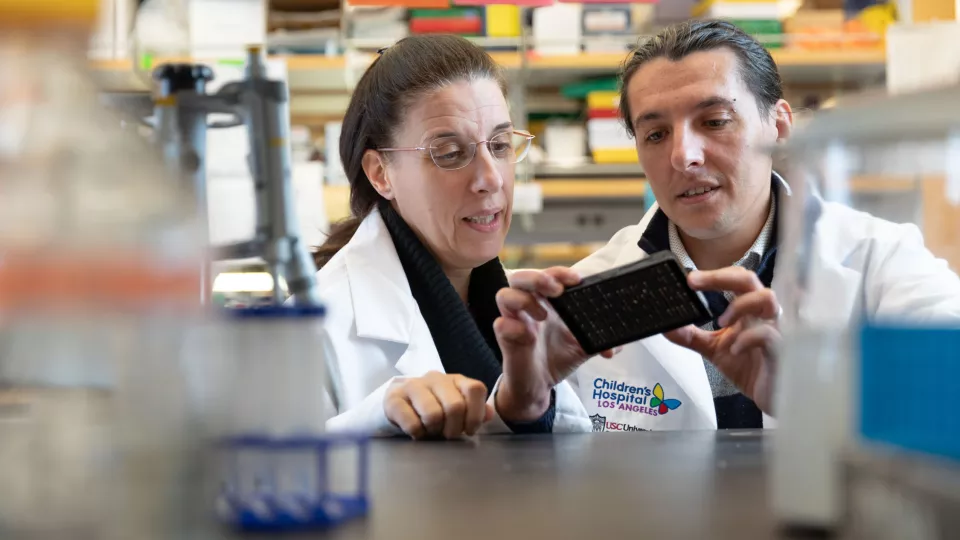
L-R: Laura Perin, PhD, and Stefano Da Sacco, PhD
CHLA Researchers Uncover Underlying Mechanism Driving Membranous Nephropathy, Offering Insights Into Chronic Kidney Disease in Children
No therapies currently exist that can halt the progression of chronic kidney disease in children or restore the ability of kidney cells to filter blood. Recently, researchers at the GOFARR Laboratory for Organ Regenerative Research and Cell Therapeutics in Urology in The Saban Research Institute of Children’s Hospital Los Angeles found new clues to understanding how chronic kidney disease progresses. By mapping the underlying genetic drivers of a type of chronic kidney disease called primary membranous nephropathy, they seek disease markers that could point the way to developing new treatments for children. In a paper published in the journal JCI Insight, the research team found that an unexpected mechanism was responsible for the loss of the kidney cells’ ability to filter toxins from blood.

“We have a good idea of what happens in the process of various types of chronic kidney failure, but we still don’t know precisely why and where it happens,” says Stefano Da Sacco, PhD, Investigator, Urology Research at CHLA and study senior author. “Our goal was to scrutinize the molecular processes of any underlying mechanisms that could cause kidney podocytes to fail and lose their blood filtering capacity. Membranous nephropathy, which affects adults, can serve as a disease model for other chronic kidney disease processes that affect children and adults alike. The glomerulus-on-a-chip platform that we developed at the GOFARR lab allowed us to agnostically query different pathways involved in disease progression and measure their impact.”
A different culprit entirely
In membranous nephropathy, infection-fighting autoantibodies destroy the kidney’s glomerular structures that contain the specialized podocytes that maintain the kidney’s filtration barrier. The researchers modeled membranous nephropathy caused by anti-phospholipase A2 receptor (PLA2R) antibodies. PLA2R is a target antigen recognized by the body’s immune system in about 70% of adults with membranous nephropathy. (Another antigen, SEMA3B, is prevalent in the rare pediatric cases that make up between 1% to 3% of total membranous nephropathy patients.) As the anti-phospholipase A2 receptor autoantibodies bind to the target PLA2R antigen—which resides on the surface of kidney podocytes—they trigger a cascade of events that leads to podocyte injury, destroying the kidney glomerular cells’ capacity to filter toxins from blood.
Previously, researchers believed that the membrane-attack-complex (MAC) was the sole driver of podocyte injury, and that inhibiting it was key to halting disease progression. The GOFARR research team discovered instead that signaling in the C3a/C3aR pathway plays a critical role in the progression of membranous nephropathy. The team tested this insight both in vitro and using the glomerulus-on-a chip-tissue model, showing that administering a C3aR antagonist could preserve the podocyte’s ability to filter blood. When Dr. Da Sacco’s team specifically blocked signaling in the C3aR gene pathway by silencing the C3aR gene in podocytes, they observed that the system retained filtration capabilities. But when the researchers prevented MAC formation, podocyte function kept deteriorating.
“By probing what is actually happening at the molecular level, we found that an entirely different pathway than we initially thought was the main driver for primary membranous neuropathy,” says Dr. Da Sacco, Assistant Professor of Research Urology at the Keck School of Medicine of USC. “We had previous knowledge that this pathway could cause damage to podocytes, but no confirmation that it was important in membranous nephropathy. We were a bit surprised and greatly encouraged. Finding what causes podocytes to fail is a step toward preventing—and eventually reversing—kidney deterioration. Our patients need better treatment options.”
This work was supported by grants from NIH/NIDDK (RO1, R01DK123234) and by the GOFARR Foundation from the Schenkman Family.


